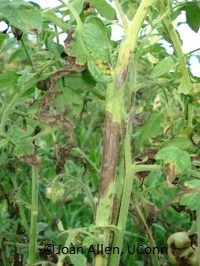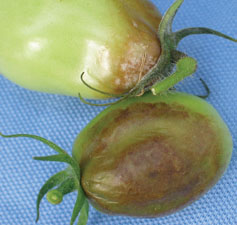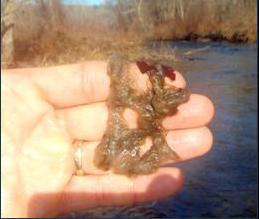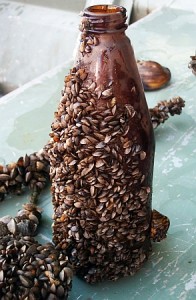CONTENTS:
People have been receiving unsolicited packages containing seeds that appear to have originated in China. DO NOT PLANT! USDA asks residents to forward the packages to them. For details and address, see the CAES Press Release
The deadly "kissing bug" has been confirmed in dozens of U.S. states. It hasn't been found in Connecticut but has been confirmed in Pennsylvania and potentially in New Jersey. Click HERE to read more on this from Brian McCready, Patch National. Also, click HERE for a Q&A and a 7-page booklet from Texas Chagas Task Force, with photos, on the topic. (posted 4/28/19)
Cornell Cooperative Extension of Rensselaer County finds new pest in Rensselaer County—Emerald ash borer, a new invasive pest, appears to have infested ash trees in the hamlet of Wynantskill in the Town of North Greenbush. Scientists from the NYS Department of Environmental Conservation reported finding an adult emerald ash borer (EAB) in a trap in that area in November. Following that tip, David Chinery from Cornell Cooperative Extension visited the area and found the infested trees. EAB kills ash trees (Fraxinus species) and has been spreading across the country since it was discovered in Michigan in 2002. This is the first time it has been confirmed in trees in Rensselaer County. Ash trees can be treated with an insecticide to protect them. Dying ash trees can be a hazard when they fall. To see photos of the infested trees and for more information on EAB, contact Cornell Cooperative Extension at (518) 272-4210. (posted 1/2/16)
Joan Allen of UConn Plant Diagnostic Lab reported the following: Tomato and potato growers and gardeners: Protect your crops NOW from late blight infection. The disease has been reported in Litchfield County, Connecticut on July 18, 2015. With moist weather conditions the pathogen, Phytophthora infestans, will sporulate prolifically and spread rapidly on wind currents. Fungicide products can be applied preventively to protect plants. Active ingredients to look for include chlorothalonil, maneb, mancozeb, and copper formulations. Organic growers can use copper formulations. Symptoms of late blight include large brown leaf lesions, dark brown stem lesions, and brown, bumpy and firm lesions on fruits. During humid or wet weather, white sporulation will be visible within the lesions. Infected plant parts or plants should be removed and disposed of. Bag and place in the trash or bury about a foot deep. More information and photos are available in the fact sheet at this website. Contact: Joan Allen, UConn Plant Diagnostic Lab, joan.allen@uconn.edu, (877) 486-6271. (posted 7/30/15)
Donna Ellis, Senior Extension Educator at UConn, sent the following:

Photos courtesy of Pennsylvania Department of Agriculture
Please see the Pest Alert and follow this link for information regarding the Spotted Lanternfly, a new insect pest recently confirmed in Pennsylvania, the first detection in the US. The Spotted Lanternfly is a planthopper native to Asia that attacks numerous hosts, including grapes, fruit trees, pines, and more than 70 other species. In the fall, adults can be found on the invasive plant Tree-of-heaven (Ailanthus altissima). (posted 2015)
Ticks can transmit more than just Lyme disease, and some of these infections may require immediate treatment and a trip to the emergency room. Read the below articles for more information. (posted 5/10/2014)
The brown marmorated stink bug, Halyomorpha halys, is a voracious eater that damages fruit, vegetable, and ornamental crops in North America. For more information visit the Stop BMSB site as well as “How to Identify the Brown Marmorated Stink Bug” and read The NYT article “Wanted Dead or Alive (No, Just Dead)” here. Photo credit Penn State. (posted 1/18/2014).
From DEEP—The Connecticut Agricultural Experiment Station (CAES) announced today that the emerald ash borer (EAB) (Agrilus planipennis) has been detected in another Connecticut county—Fairfield—in the town of Sherman, CT on July 19, 2013. This invasive insect has now been found in two Connecticut counties and twelve towns. The identification of EAB has been confirmed by the federal regulatory officials in the USDA Animal and Plant Health Inspection Service, Plant Protection and Quarantine (USDA-APHIS-PPQ). This new county detection, like that of the initial New Haven County detection in 2012, was made through the Experiment Station’s Cerceris wasp biosurveillance program. Visit DEEP/Emerald Ashborer for more information. (7/26/13 press release)


Late blight on tomato & potato
Credit Joan Allen UConn
From UConn—Late Blight Confirmed in MA—Protect Your Tomatoes! Tomato and potato growers and gardeners: Protect your crops NOW from late blight infection. The disease has been reported in New England in Franklin County, Massachusetts on July 11, 2013. With moist weather conditions the pathogen, Phytophthora infestans, will sporulate prolifically and spread rapidly on wind currents. Fungicide products can be applied preventively to protect plants. Active ingredients to look for include chlorothalonil, maneb, mancozeb, and copper formulations. Organic growers can use copper formulations. Symptoms of late blight include large brown leaf lesions, dark brown stem lesions, and brown, bumpy and firm lesions on fruits. During humid or wet weather, white sporulation will be visible within the lesions. Infected plant parts or plants should be removed and disposed of. Bag and place in the trash or bury about a foot deep. More information and photos are available in the fact sheet at this website: www.ladybug.uconn.edu—UConn Home & Garden Education Center. (posted 7/12/13)
From UMass—Late Blight (LB) was confirmed in Franklin County, MA on tomato July 11, 2013, in Erie County, NY on tomato July 10th and on potato July 9th. Previous reports in (FL, WV, LA, TN, MD, KY, VA, NC, WI) have been confirmed as Phytophthora infestans strains US-23 and US-7. Commercial tomato and potato growers should be spraying those crops with protectant, curative and locally systemic fungicides labeled for oomycetes to prevent disease establishment and spread. For pictures and more information https://extension.umass.edu/vegetable/alerts. Advice for home gardener clientele: At this point in the season if symptoms begin appearing on plants, remove plants, place in a plastic bag, seal and discard in the trash or completely bury plants deep enough underground so plants decompose and will not re-sprout. Do not put the plants in a compost pile as spores will still spread from this debris. For more details, images, and management options, go to https://ag.umass.edu/fact-sheets/home-lawn-garden/late-blight-tomatoes-and-potatoes. Track disease progress at USA BLIGHT at https://usablight.org/. If you suspect late blight, contact the UMass Plant Diagnostic lab 413-545-3208. (posted 7/12/13)
Cornell Cooperative Extension (CCE) is providing educational assistance to small businesses regarding the federal healthcare law, known as the Affordable Care Act (ACA). CCE is conducting free community presentations and one-on-one educational sessions to help small businesses navigate healthcare reform. CCE has staff available to answer these questions and discuss any others you may have. Feel free to contact them for more information: Kirk Shoen, kjs264@cornell.edu (518) 272-4210, Ashley Pierce, arp253@cornell.edu (518) 272-4210 and Sandy Buxton, sab22@cornell.edu (518) 746-2560. (5/13/2013 press release from CCE)
According to UConn’s site, “A red beetle is voraciously consuming the foliage of true lilies (not daylilies). It is a relatively new pest, native to Europe. The lily leaf beetle (Lilioceris lilii) feeds on new growth and flower buds. It is present in Massachusetts and New Hampshire and was spotted in several locations in Connecticut last year. If you have this 1/4 inch long beetle feeding on your lilies, call the Home and Garden Education Center at 1-877-486-6271 or check out our website for identifying photos at www.ladybug.uconn.edu.” Researchers at UConn are conducting a lily leaf beetle biological control project during the 2013 summer. If you grow lilies in Connecticut, have a minimum of 12 plants in the lily family (Oriental lilies, Asiatic lilies, Turk’s Cap lilies, or Fritillaria) in your garden, and have lily leaf beetles feeding on them, we would like your help. We will be introducing three species of beneficial parasitic wasps in June and would like to collect lily leaf beetle larvae from June through August. The parasitic wasps attack lily leaf beetle larvae, and over time these natural enemies will disperse from release sites and begin to spread through the state to reduce populations of lily leaf beetles. The wasps were first introduced in Connecticut in 2012 and have also been released in Maine, Massachusetts, New Hampshire and Rhode Island, where they are establishing and starting to impact lily leaf beetle populations. Please contact Donna Ellis (email donna.ellis@uconn.edu; phone 860-486-6448) if you would like to participate in the research project. For more information about the lily leaf beetle visit https://faq.gardenweb.com/faq/lists/neweng/2002040522017914.html (posted 5/13/2013).
November 5, 2012—University of Connecticut, Home & Garden Education Center. For immediate release: Salt Water Contamination of Soils by Hurricane Sandy: Many coastal Connecticut residents have contacted the University of Connecticut Soil Nutrient Analysis Laboratory because of their concerns of salt contamination from either flooding or storm surges. The amount of damage done to plants will depend on the salinity of the water, how long the plants were in contact with it, and also, to some extent on plant species. The best way to counteract the desiccation caused by salts is to leach them out with fresh water. With more rain in the forecast for later this week, the salt problem may be taken care of in sandy, well-drained soils. Greatest problems for plants are those situated in low lying, poorly drained or heavily flooded areas and even with more rain, there is no place for the salts to go. In all likelihood, plants in these areas will die, the salts will leach out eventually over the winter and the area would need to be replanted next spring. Gypsum is not especially effective except in limited circumstances. The lab does offer testing of soluble salt levels. For more information, call us at (860) 486-4274 or visit www.soiltest.uconn.edu. Another issue to consider besides salt, is the possibility for contamination from septic systems, water treatment plants, businesses, industry and waste sites. Testing for these types of materials is more difficult and costly. Contact: Dawn Pettinelli, UConn Soil Nutrient Analysis Laboratory, dawn.pettinelli@uconn.edu, (860)486-4274.
September 7, 2012—Downy mildew of impatiens has been confirmed in residential and commercial landscapes throughout Connecticut. All cultivars of the common garden impatiens, Impatiens walleriana, are susceptible; however, New Guinea impatiens appear to be tolerant to downy mildew. This pathogen does not infect cucumbers or squash (or any vegetable) or any other common bedding plants. The downy mildew pathogen is spread by infected plants, water/rain, and wind. It can splash from plant-to-plant within a landscape bed or can be airborne and travel over much longer distances. Early symptoms of downy mildew begin as light-green yellowing, mottling, or stippling. For photos click here. For more information visit https://www.ct.gov/caes/cwp/view.asp?a=3756&q=442800&caesNavPage=|
From UMass—All Impatiens walleriana are susceptible. New Guinea impatiens and other bedding plants are not hosts for this disease. Infected plants should be removed from the greenhouse, landscape or garden, roots and all and discarded. Do not compost. A new, revised (9/12) fact sheet is available to distribute to home gardening customers to help answer questions. See attached or go to https://extension.umass.edu/floriculture/sites/floriculture/files/fact-sheets/retail-factsheets/12ImpatiensDM.pdf

Late Blight on tomato (Cornell University)
June 20, 2012—For immediate release, from University of Connecticut Home & Garden Education Center: An important disease of tomato and potato, late blight, has been confirmed in New Haven County on June 20th. This disease can kill plants rapidly under favorable weather conditions including rainfall or high humidity and moderate temperatures. Disease will not develop and spread in hot, dry weather. Symptoms include dark brown stem lesions, large brown leaf lesions, and firm, brown and sometimes rough lesions on tomato fruit. White, fuzzy sporulation may be visible on leaf undersides and stem lesions. Minimize disease by spacing, staking and pruning tomato plants to promote drying airflow around them Avoid overhead irrigation. Fungicides may be used preventively. Read and follow all label instructions carefully. If you suspect late blight infection, plant samples can be diagnosed at your nearest county extension office or at the UConn Plant Diagnostic Lab in Storrs (Call toll-free in Connecticut: 877-486-6271). Plants confirmed for late blight should be removed and buried or bagged for disposal. Contact: Joan Allen, Assistant Cooperative Extension Educator in Residence, UConn Home & Garden Education Center, (860)486-6740, joan.allen@uconn.edu. For more information and photographs of late blight please visit Cornell University’s page on this topic: https://www.nysipm.cornell.edu/publications/blight/ (posted 6/25/12)
The Warm Winter of 2012 and What to Expect From Winter Moth in Massachusetts. The big question now is what has this done to the timing of winter moth egg-hatch for the upcoming growing season? Attached is a news release from UMass Extension concerning the winter moth caterpillar, an introduced pest now occurring in Eastern MA and most of RI, with huge numbers of over-wintering eggs expected to hatch soon. Last year, WM defoliated about 80,000 acres in eastern MA. https://extension.umass.edu/landscape/news/warm-winter-2012-and-what-expect-winter-moth-massachusetts
Bad Lyme Disease Spring Predicted for Northeast— For more information read the following two articles. https://commonhealth.wbur.org/2012/03/lyme-disease-spring AND https://www.cdc.gov/lyme/prev/on_people.html
In addition, Kathleen Nelson suggests: You have two chances to find ticks each day: Once as you shower, using your hands to detect tiny bumps as you soap and rinse. And once with a long handled mirror as you check ALL parts of your body. Don’t skip anything, and be sure you do it EVERY day. If you miss a tick, the visual search may also pick up a tell-tale bulls eye rash. If you find a rash, get treatment immediately. And: DO NOT THROW YOUR WORK CLOTHES ONTO THE BED!!!!
From UMASS/Amherst Center for Agriculture: In October 2011, boxwood blight (Cylindrocladium pseudonaviculatum) was positively identified in Connecticut. This is the first confirmed incidence of boxwood blight in the United States. Please see https://extension.umass.edu/landscape/news/boxwood-blight-found-connecticut and https://extension.umass.edu/landscape/sites/landscape/files/fact-sheets/pdf/boxwood_blight_CAES.pdf for more information (posted 12/9/11).
The Connecticut Department of Agriculture has links for flood-related damage reporting and information concerning crops that have be in contact with flood waters. Details: Storm Damage Assistance Available for Agricultural Producers, more Late blight resources HERE. For organic management of late blight, go HERE for details. (posted 9/12/11)
Caryn Rickel from Seymour is being overtaken by giant Invasive running bamboo invading from a neighboring property. Yellow Groove Bamboo, Phyllostachys aureosulcata, grows up to 40 feet high and is perfectly hardy here. It takes a few years to start spreading , but once it does, watch out. It grows taller and invades underground more aggressively each successive year.
A mature grove ( at approx. 12 years ) can wreak havoc with gardens, pools, septic systems, pavement and foundations. There are all kinds of recommendations on how to contain it, but none work very well. In the long run the barriers fail. The plant quickly forms dense thickets which choke out all native vegetation.
Caryn is working very hard to get legislation in Connecticut similar to that passed recently in other states and communities. There are two possibilities: one is adding this species to the Connecticut Invasive Plant list, the other is legislation that would specify a buffer distance between the species and property boundaries, and require barriers and maintenance to prevent the plants from over-running neighboring properties.
She would appreciate your help in locating out-of-control stands of giant running bamboo. All the stands she has found so far are this species. Groves that appear to not have been planted are of particular interest. So far she has located one such stand in Southbury on the upstream side of a bridge opening on the Pomperaug River. The starter plant probably came from one of four large populations that have invaded the floodplain upstream.
Please send reports to Kathleen Nelson, knelson@madgardeners.com. I’ll forward them to Caryn. (posted 7/14/11)
July 2012—The Emerald Ash Borer has recently been seen near western Connecticut. Please click on the below links for more information. The complete press release includes an email from Thomas Worthley of the Middlesex County Extension Center regarding efforts to trap the bug and requesting help and suggestions.
Update 7/20/12: Emerald Ash Borer found in Prospect and Naugatuck CT. For More information see: https://newyork.cbslocal.com/2011/05/19/buggy-invasion-could-be-headed-to-connecticut/ and also https://www.ct.gov/dep/cwp/view.asp?A=2697&Q=464598
Landscapers, arborists,and nursery growers please take note: as of January 2011, the address of the UMass Extension Plant Diagnostic Lab for sending samples is: UMass Extension Plant Diagnostic Lab, 101 University Drive, Suite A7, Amherst, MA 01002. Complete information for sending samples to the UMass Extension Plant Diagnostic Lab, including sampling instructions and submission forms, can be found at https://www.umass.edu/agland/diagnostics. For directions to the lab, go to https://www.extension.umass.edu/agriculture/index.php/services/plant-problem-diagnostics/visiting-lab

First Confirmation of this Invasive Species in Connecticut March 2011—The Connecticut Department of Environmental Protection (DEP) announced that the highly invasive freshwater alga, Didymosphenia geminata, known as “didymo”, has been discovered in the West Branch Farmington River, a very popular trout stream in northwestern Connecticut.
The presence of didymo was first confirmed in the northeastern United States in 2007, and has since spread to other popular trout streams in a number of northeastern states (New Hampshire, Vermont, New York, Pennsylvania, Maryland, West Virginia and Virginia). This is the first report of didymo in Connecticut.
DEP first learned of the possible presence of didymo in the West Branch Farmington River from several anglers on March 18th . One of these anglers also provided an initial sample to DEP. Following initial review by DEP staff, samples were sent to the Vermont Department of Environmental Conservation where biologists have direct experience identifying didymo. Late last Friday, Vermont officials confirmed that the sample was indeed didymo.
“This find is very troubling,” said DEP Deputy Commissioner Susan Frechette. “Extensive blooms of this organism can harm the river ecosystem and decrease its recreational and economic value.”
For more information, download the press release through this LINK .

(credit: Environmental Headlines)
Robert Miller, Staff Writer—New Milford Spectrum
September 2011—The public boat launches on the Houstonic River’s three big lakes — Candlewood, Lillinonah and Zoar — have clear signs of warning: Beware of zebra mussels.
Now the public education effort may move north, up river.
That’s because there’s increasing evidence zebra mussels in their nymphal stage exist along the length of the river in Connecticut.
People kayaking and canoeing in the river could carry those nymphs — called veligers — to other bodies of water unless they’re warned to clean their boats.
“It’s not a question of whether anymore,” Lynn Werner, executive director of the Housatonic Valley Association, said about the need for education along the river. “It’s a question of when.”
At a recent meeting of the Zebra Mussel Task Force — a group of town officials and lake advocates formed in 2010 after the adult mussels were found in Lillinonah and Zoar — Gary Smolen of FirstLight Power Resources said the utility’s own monitoring efforts found veligers at two of the company’s hydroelectric power plants: in Falls Village and at the Rocky River power plant in New Milford.
Inexplicably, Mr. Smolen said, the veligers haven’t been found yet at the Bull’s Bridge power plant near the Kent-New Milford town line — the plant that lies between Falls Village and New Milford.
Read more: https://www.newmilfordspectrum.com/local/article/Zebra-mussels-move-into-the-Housatonic-2149909.php#ixzz1axf6iwla (From New Milford Spectrum, Friday, Sept. 2, 2011)
 Email:
MadGardener@MadGardeners.org
Email:
MadGardener@MadGardeners.org
 Mailing Address: PO Box 146, Sherman, CT 06784-0146
Mailing Address: PO Box 146, Sherman, CT 06784-0146
Copyright © 2020 Mad Gardeners. All rights reserved.